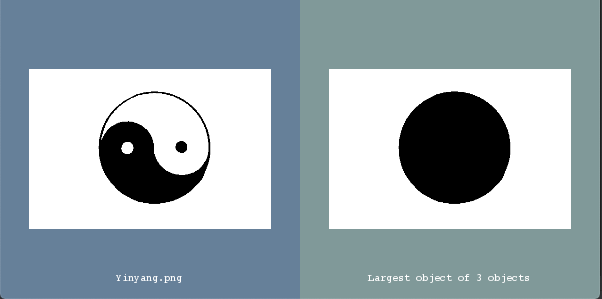Extra Largest Connect Component From Binary Image#
Synopsis#
Extract the largest connected component from a Binary Image.
Results#

Input image.#

Output In VTK Window#
Output:
Number of objects: 3
Code#
C++#
#include "itkImage.h"
#include "itkImageFileReader.h"
#include "itkConnectedComponentImageFilter.h"
#include "itkLabelShapeKeepNObjectsImageFilter.h"
#include "itkRescaleIntensityImageFilter.h"
#include "itksys/SystemTools.hxx"
#include <sstream>
#ifdef ENABLE_QUICKVIEW
# include "QuickView.h"
#endif
int
main(int argc, char * argv[])
{
if (argc < 2)
{
std::cout << "Usage:" << std::endl;
std::cout << argv[0] << " InputFileName" << std::endl;
}
constexpr unsigned int Dimension = 2;
using PixelType = unsigned char;
using ImageType = itk::Image<PixelType, Dimension>;
const auto input = itk::ReadImage<ImageType>(argv[1]);
using OutputImageType = itk::Image<unsigned short, Dimension>;
using ConnectedComponentImageFilterType = itk::ConnectedComponentImageFilter<ImageType, OutputImageType>;
auto connected = ConnectedComponentImageFilterType::New();
connected->SetInput(input);
connected->Update();
std::cout << "Number of objects: " << connected->GetObjectCount() << std::endl;
using LabelShapeKeepNObjectsImageFilterType = itk::LabelShapeKeepNObjectsImageFilter<OutputImageType>;
LabelShapeKeepNObjectsImageFilterType::Pointer labelShapeKeepNObjectsImageFilter =
LabelShapeKeepNObjectsImageFilterType::New();
labelShapeKeepNObjectsImageFilter->SetInput(connected->GetOutput());
labelShapeKeepNObjectsImageFilter->SetBackgroundValue(0);
labelShapeKeepNObjectsImageFilter->SetNumberOfObjects(1);
labelShapeKeepNObjectsImageFilter->SetAttribute(
LabelShapeKeepNObjectsImageFilterType::LabelObjectType::NUMBER_OF_PIXELS);
using RescaleFilterType = itk::RescaleIntensityImageFilter<OutputImageType, ImageType>;
auto rescaleFilter = RescaleFilterType::New();
rescaleFilter->SetOutputMinimum(0);
rescaleFilter->SetOutputMaximum(itk::NumericTraits<PixelType>::max());
rescaleFilter->SetInput(labelShapeKeepNObjectsImageFilter->GetOutput());
#ifdef ENABLE_QUICKVIEW
QuickView viewer;
viewer.AddImage(input.GetPointer(), true, itksys::SystemTools::GetFilenameName(argv[1]));
std::stringstream desc;
desc << "Largest object of " << connected->GetObjectCount() << " objects";
viewer.AddImage(rescaleFilter->GetOutput(), true, desc.str());
viewer.Visualize();
#endif
return EXIT_SUCCESS;
}
Classes demonstrated#
-
template<typename TInputImage, typename TOutputImage, typename TMaskImage = TInputImage>
class ConnectedComponentImageFilter : public itk::ImageToImageFilter<TInputImage, TOutputImage>, protected itk::ScanlineFilterCommon<TInputImage, TOutputImage> Label the objects in a binary image.
ConnectedComponentImageFilter labels the objects in a binary image (non-zero pixels are considered to be objects, zero-valued pixels are considered to be background). Each distinct object is assigned a unique label. The filter experiments with some improvements to the existing implementation, and is based on run length encoding along raster lines. If the output background value is set to zero (the default), the final object labels start with 1 and are consecutive. If the output background is set to a non-zero value (by calling the SetBackgroundValue() routine of the filter), the final labels start at 0, and remain consecutive except for skipping the background value as needed. Objects that are reached earlier by a raster order scan have a lower label. This is different to the behaviour of the original connected component image filter which did not produce consecutive labels or impose any particular ordering.
After the filter is executed, ObjectCount holds the number of connected components.
- See
ImageToImageFilter
- ITK Sphinx Examples:
Subclassed by itk::ConnectedComponentFunctorImageFilter< TInputImage, TOutputImage, Functor::SimilarPixelsFunctor< TInputImage::ValueType >, TMaskImage >, itk::ConnectedComponentFunctorImageFilter< TInputImage, TOutputImage, Functor::SimilarVectorsFunctor< TInputImage::ValueType >, TMaskImage >, itk::ConnectedComponentFunctorImageFilter< TInputImage, TOutputImage, TFunctor, TMaskImage >
